by Winding Pathways | Dec 23, 2021 | (Sub)Urban Homesteading, Energy Efficiency, Uncategorized
We knew natural gas prices were way up but our $80+ November bill both surprised and pleased us.
Surprise: That’s a high bill for us.
Pleased: Our efforts at energy efficiency and wise house management kept the bill from being higher.
Nearly everyone can reduce heating costs. Some actions are long-term, like adding insulation, replacing drafty windows, or installing a wood stove. There’s not enough time this year to put these in place this winter.
Here are short term ways to reduce the heating bill at either no, or low, cost:
- Open south-facing window blinds on sunny days. The sun will warm the room and never send a bill. Close the blind when the sun calls it quits and sets for the day.
- Caulk holes and cracks. We bought a spool of “rope caulk”. It’s putty that won’t harden, comes in a roll, and is easy to press into cracks, especially around windows.
- Replace the furnace filter. If it gets clogged with dust the furnace has to work harder, and that costs money. Write on the filter the date you replace it so you know. Then, make a note on your planner to check and replace. Some furnaces also send alerts to change a filter.
- Wear comfy sweaters and socks and set the thermostat down a few degrees. We often nestle under a blanket or throw when watching tv or reading in the evening.
It’s going to be an expensive heating winter, but taking a few simple efficiency steps will remove some of the monthly bill’s sting.
by Winding Pathways | Oct 21, 2021 | (Sub)Urban Homesteading, Chickens, Energy Efficiency, Preparedness
Like many people with a small flock of backyard chickens, we faced a dilemma.
Our birds are housed in a coop built inside a pole barn. There was no electric power in our barn.

The chickens kept on laying eggs.
Fall’s Shortening days signals chickens to slow egg production just as many families need plenty of eggs for the holiday baking season. Placing a timer-controlled light in the coop, set to come on early each morning, gives chickens the optimal 15 hours of combined artificial and natural light they need to keep laying.
Lights and timers need electricity that our barn lacked. So, years ago, we hired an electrician to trench a wire from our house to the barn and add outlets and overhead lights. It works fine but the electrician’s bill was stiff and our chicken lights add to our monthly power bill. Now there’s a less expensive option.
P.S. The Holidays are coming….This might be a great gift for chickens and caregivers!
-

-
After trenching the wire was laid down.
-

-
We hired a company to install solar panels on the barn roof.
-
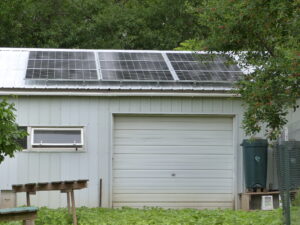
-
Solar powers our home and the light needed for the coop.
Batteries, light bulbs, and solar collectors have become much more efficient and less expensive. It’s now easy to purchase a solar electric system to power outbuildings that lack electricity.
Alternative Light Options
Big box stores sell security lights that include a solar collector, occupancy sensor, battery, and light bulb. The collector creates electricity during the day that charges the battery. The sensor recognizes when a person approaches in the dark and turns on the light. These are fine for their intended purpose but don’t work to add a few extra hours of timer-controlled light for chickens.
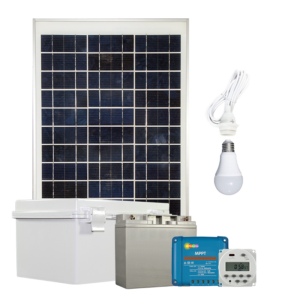
A portable solar kit costs around $400, is easy to install and to light your way. (Courtesy Solar Illuminations)
We recently learned of a company called Solar Illuminations, which can create lighting solutions for chicken coops and other outbuildings. A kit including a solar collector, battery, timer, fixture, and the bulb is just over $400. Sounds expensive but likely is less costly than hiring an electrician to run a wire. And, the sun never sends a bill for electricity generated by a solar panel.
Installing a system is easy and doesn’t require an electrician. Systems can also be designed to power an aquarium aerator that will help keep drinking water unfrozen on cold nights or provide work light in an outbuilding.
We love modern technology’s ability to harness the sun’s energy to give hens a few extra hours of light during winter’s darkness. The result is more eggs without adding a penny to the monthly electric bill.
*Note: Winding Pathways received no special compensation or materials from companies in writing this blog.
by Winding Pathways | Apr 29, 2021 | (Sub)Urban Homesteading, Energy Efficiency
Many people dread the arrival of their monthly electric bill. Not us.
We recently received a $13.38 monthly bill from Alliant Energy for electricity used in March. A day later Enphase Energy emailed us our March photovoltaic production. That’s correct. Thirteen dollars and thirty-eight cents.
Our bill is about 1/10th the national average homeowner’s bill and is small thanks to three actions. Here’s what we do:
- Shut “it” off: We are stingy on both money and wasteful appliances being on. If we’re not using lights, computers, the television, toaster, radon machine (that we turn off when we happen to be gone), or other electricity consumers we turn them off. We never leave outside lights on all night. They are wasteful, advertise where you live, and diminish the night sky. The latter we are learning is more important to humans than realized.
- Embrace efficiency: Our house is almost entirely lit by LED bulbs with a few fluorescents and no incandescents. LEDs use only a tiny bit of electricity to provide outstanding light, and when we purchase appliances, we choose those most efficient.
- Installed photovoltaics. We installed a small system four years ago and reaped federal and state tax credits. As soon as the system went active our bills plummeted.
- Of course, in order to do the above, one has to plan and save money by doing the simple acts of turning off electric sources and long-term spend on only what you truly need.

On sunny days solar powers our energy needs.
Every month Enphase Energy emails us a report of our prior months’ electric production. March 2021 was mostly sunny and clear and our system produced 283 kilowatts. February was a dark winter month and our system was blanketed with snow. The system only made 76 KWH. However, as days lengthen our nine solar panels will produce ever more electricity, keeping our monthly bill low.
by Winding Pathways | Apr 15, 2021 | (Sub)Urban Homesteading, Energy Efficiency
During recent cold months, we’ve been day-tripping to many museums as we research our articles for the Cedar Rapids GAZETTE.
On an early March morning electric car specialist, William Weiland, at Cedar Rapids McGrath Chevyland showed us how to drive a Bolt, a completely electric car. Soon we sped the 70 miles to Dubuque without burning a drop of gas. After a pleasant and productive visit to the Mississippi River Museum and Aquarium and picnic at Mines of Spain, we drove back to Cedar Rapids and returned the car.
First Experience
It was our first experience driving a totally electric vehicle. We were impressed. As is common with anyone considering going electric, we worried about having enough battery capacity for the 160 miles we drove on a cold, windy day. We didn’t need to worry The Bolt’s “gas gauge” is an easily viewed display of electricity used and remaining and clearly shows how many more miles we could go until the battery was drained. We could have done our Dubuque trip and continued another 50, or so, miles before it needed recharging.
How Does the bolt Compare?
We own and like a Chevy Cruze, which is an efficient and comfortable gasoline engine car. It is approximately the same size as the Bolt, so our drive gave us an opportunity to compare similarities and differences between cars. Here’s what we noted about the Bolt:
- It’s fast and powerful. Step on the acceleration pedal and it smoothly and quickly powers forward. The Bolt is gutsier than our Cruze.
- It’s quiet.
- It’s comfortable. Much more legroom for front-seat occupants than the Cruze, although the back seat has less legroom.
- It’s an engineering marvel. The Bolt goes about 280 miles on a charge and can be recharged in several ways. It lacks nothing in electronic capability. Just about any device can be connected, and the audio was of top quality.
-
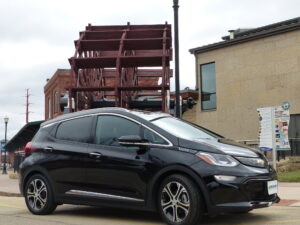
-
Two forms of transportation
-
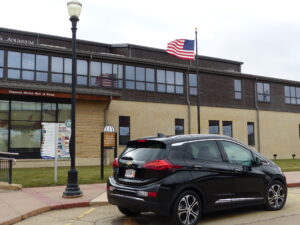
-
Maintenance costs are low on a Bolt.
How Does a Bolt Work?
- It regenerates energy. This took a bit of getting used to. When going down a hill or slowing for a red light or stop sign the Bolt automatically “brakes.” Although it really isn’t braking. Taking a foot off the acceleration pedal causes the car to slow and stop by generating electricity that is later used for forward motion. So, it’s slowing the car without engaging brakes. We found it important to ease our foot pressure off the accelerator pedal to slow down rather than taking the foot off immediately. This avoids being rear-ended by vehicles behind us. After getting the hang of this we really liked the feature. The Bolt has conventional brakes and a brake pedal that can be used. But, because of regenerative braking, the conventional brakes are used much less than on a gas car, so they last longer.
- It’s efficient. We used 50 Kilowatt-hours of electricity from the battery to go 160 miles or just over three miles per KWH. Our electric utility charges us 11 cents a KWH at home, so charging the Bolt would cost about 3.7 cents a mile. Our Cruze gets about 36 miles to the gallon on cold windy days and gas costs about $2.80 a gallon as we write this. That’s about 8 cents a mile or a hair over double the bolt’s fuel cost. Gas prices are rising faster than electricity so the gap will widen.
Maintenance Matters
- Maintenance needs and costs are lower. Electric cars do not need oil changes, since they have no oil. Also, no radiator or need to change coolant. No spark plugs to change. Basically, maintenance involves rotating tires.
-

-
The Bolt is quick and agile.
-
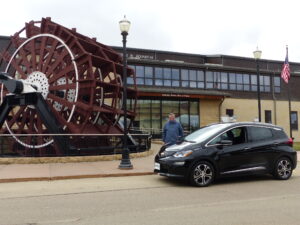
-
A tall person has plenty of legroom in a Bolt.
Overall Impression and Conclusion
Before our test drive, we thought we might buy an electric car in the future. Now we’re certain we will. General Motors will switch to entirely electric vehicles, and many other car companies are also making the transition. It’s transformative. As more electrics hit the road more charging stations will appear and technology will continue to advance. We are entering an electric future that will be cleaner and quieter than our petroleum present.
* Winding Pathways was not paid to review the Chevy Bolt. Ours is an independent review.
* For another independent review see www.caranddriver.com/chevrolet/bolt-ev.
by Marion Patterson | Nov 26, 2020 | (Sub)Urban Homesteading, Energy Efficiency
Many people cringe when the monthly electric bill arrives. Not us. In 2019 the average homeowner in the United States paid $115 a month. Our last bill was $13. That is right! Thirteen bucks. Almost everyone can tame their electric bill. Here’s how we did it:
- Replaced incandescent and compact fluorescent bulbs with LED (Light Emitting Diode) bulbs. They last almost forever and only use about a fifth the electricity of incandescents. LED bulbs were once expensive but now are as low as $1 each.
- Purchased high-efficiency Energy Star Rated appliances. Yes, you pay more upfront. The savings are significant over time.
- Turn it off! The human index finger has enormous bill cutting power and is free. If a light, television, computer, or any other power-consuming device is not being used…. we turn it off. Remember many of today’s appliances are “vampires.” All those glowing lights on appliances collectively suck energy and balloon your bill. Some you cannot unplug or turn off. Others you can.
- Avoid night lighting. Our outdoor lights stay “off” unless we need them briefly for outdoor work. Use motion light sensors if you think you need to be aware of outside activity at night.
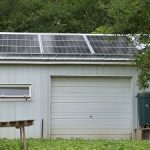
Soaking up the sun.
After completing the above steps, we installed photovoltaics on the barn’s roof. Photovoltaics (PV) are panels that use the sun’s energy to create electricity. Electricity generated by our small system partially powers our home’s needs. When we produce more than we’re using it flows out to the power grid. When we’re using more than we make, which always happens at night, grid power flows in. At the end of the month, we pay the “net”. Because our system is small, over time we never produce as much electricity as we use, but we make most of it. Combined with efficiency we tamed our electric bill.
The Federal Government and many states offer tax credits to homeowners who install solar. The value of credits diminishes each year, so acting soon maximizes tax savings and tames electric bills. It’s a great time to “go solar”.
by Winding Pathways | Sep 17, 2020 | (Sub)Urban Homesteading, Energy Efficiency, Geology/Weather, Preparedness
Four years ago, we installed a net-metered photovoltaic system on our barn roof. Photovoltaics, or simply PV, is a term that means “light electricity” or solar energy.

On sunny days solar powers our energy needs.
We appreciate our PV system. On sunny days, when our system produces more electricity than we use, it runs our meter backward as power flows out into the energy grid. At night and on cloudy days, when we’re using more power than we’re producing, we draw electricity in from Alliant Energy, our utility. At the end of each month, we pay the “net” so it’s called a Net-Metered System. This eliminates the need to have storage batteries. We’ve had a monthly bill as low as $5!
But what happens when the grid goes down? It did on August 10, 2020, when a derecho roared through Iowa with 140 mile an hour winds. Hundreds of miles of wires were torn down as trees crashed into them. We joined thousands of other homes without power.

Solar chargers help keep people connected when the power goes out.
So, did our PV system power our lights, computers, and television? Nope. We used candles and lanterns when it got dark and couldn’t power our computer, television, or any other electric appliance for about two weeks.
Net-metered systems, like ours, have an automatic switch built into them so they don’t export electricity back to the grid when it’s down. It’s a safety mechanism designed to prevent a utility employee working to restore power from getting a shock. Our system produced electricity during the blackout, but it just dissipated. As soon as our power was restored the PV system again sent power outward.
An Important PV Safety Tip
Our PV system survived the wind intact but others were ripped from roofs and tumbled to the ground. A PV panel laying on the ground upright makes electricity. Grabbing wires or the panel can give someone a tremendous shock. If a PV panel is on the ground stay away……or cover it with a tarp to darken it so it doesn’t produce electricity. It’s safest to wait until after dark to flip it.












